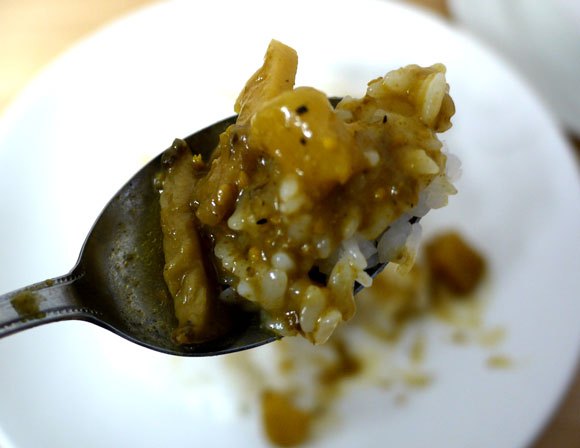
What comes to mind when you think of popular Japanese dishes? Of course, sushi and ramen top the list, but it’s also hard to leave out curry rice. Our modern notion of Japanese curry, which originally came from India and was further developed in England, came to Japan during the Meiji Era (1868-1912). However, the ingredients used for “medicinal curry” (based on Chinese medicine) have actually been in Japan for 1,300 years, since the Nara Era (710-794). We were lucky enough to find a pouch of instant “1,300-year-old curry” and just had to try it!
- 1,300-year-old curry made from ingredients used during the Nara Era
This ready-made curry is sold for 680 yen (US$6.61) per box. It may seem a bit expensive for curry in a sealed plastic pouch, but it’s worth the price for being such a unique curry made using only ingredients that existed in 1,300 years ago. The main ingredients are eggplant, taro, daikon, lotus root, shiitake mushrooms, garlic, ginger, sake lees, millet mochi, vegetable oil, miso, honey, spices, sesame seeds, black pepper, Japanese pepper (sansho), and cardamom.
Pretty cool, right? It’s amazing to think that all of these ingredients already existed in Japan by the Nara Era. We were surprised to see cardamom and black pepper on the list. While it’s true that some spices like cloves were brought by monks and envoys and stored in public storehouses, isn’t it strange nonetheless? By the way, there is no meat in this curry.
- It definitely tastes like curry!
Potatoes, onions, carrots, and other chief ingredients found in the so-called modern Japanese curry are not included at all. It really seems to be legitimate curry made using only ingredients that existed 1,300 years ago.
Without any meat, we were worried that it wouldn’t have enough flavor or body. But our worries were soon unfounded after trying it. The flavor comes mainly from the eggplant and shiitake mushrooms, and the sake lees, millet mochi, miso, sesame paste, etc. all add a subtleness to the sauce.
Furthermore, the scent of cardamom pierces your nostrils, and gives off an “I’m telling you that this is curry!” sort of vibe. It’s definitely curry! Just not the usual kind we’re accustomed to.
- Almost like fine quality pork! Satisfying with only syrupy daikon and no meat
All of the ingredients are tasty, but the daikon is worthy of special mention. It’s so thick and syrupy you would never guess it’s daikon! It’s not too bitter or strong, and blends very well with the curry. The flavor is almost as if you were eating fine quality pork bordering between lean and fatty meat.
Even though there’s no meat, it’s not lacking in anything. Rather, it makes you think that all curry could be good if it were made with only daikon.
- Warms your body even though it’s not spicy
As you can probably guess from the ingredient list, while 1,300-year-old curry tastes like how curry should taste, it’s not spicy. However, you do warm up from the inside after eating it. Yup, that’s definitely curry for you. It’s the food that is said to be made by Buddha himself by combining lots of spices.
Original article by Sawai Meg
Images: RocketNews24
[ Read in Japanese ]





 Time to vote for your favourite in Japan’s Sanrio Character Curry Election
Time to vote for your favourite in Japan’s Sanrio Character Curry Election No time to cook? No problem! Three easy ways to improve instant curry
No time to cook? No problem! Three easy ways to improve instant curry We spice up our fermented soybeans with curry powder flavored natto【Taste Test】
We spice up our fermented soybeans with curry powder flavored natto【Taste Test】 Survey ranks the most popular Japanese curry dishes during winter
Survey ranks the most popular Japanese curry dishes during winter Curry restaurants across Japan create social media movement: “Don’t blame the curry!”
Curry restaurants across Japan create social media movement: “Don’t blame the curry!” McDonald’s new Happy Meals offer up cute and practical Sanrio lifestyle goods
McDonald’s new Happy Meals offer up cute and practical Sanrio lifestyle goods All-you-can-drink Starbucks and amazing views part of Tokyo’s new 170 meter-high sky lounge
All-you-can-drink Starbucks and amazing views part of Tokyo’s new 170 meter-high sky lounge Beautiful Sailor Moon manhole cover coasters being given out for free by Tokyo tourist center
Beautiful Sailor Moon manhole cover coasters being given out for free by Tokyo tourist center More foreign tourists than ever before in history visited Japan last month
More foreign tourists than ever before in history visited Japan last month Studio Ghibli glasses cases let anime characters keep an eye on your spectacles
Studio Ghibli glasses cases let anime characters keep an eye on your spectacles Is the new Shinkansen Train Desk ticket worth it?
Is the new Shinkansen Train Desk ticket worth it? Arrest proves a common Japanese saying about apologies and police
Arrest proves a common Japanese saying about apologies and police Starbucks reopens at Shibuya Scramble Crossing with new look and design concept
Starbucks reopens at Shibuya Scramble Crossing with new look and design concept Mister Donut ready to make hojicha dreams come true in latest collab with Kyoto tea merchant
Mister Donut ready to make hojicha dreams come true in latest collab with Kyoto tea merchant The 2023 Sanrio character popularity ranking results revealed
The 2023 Sanrio character popularity ranking results revealed Disney princesses get official manga makeovers for Manga Princess Cafe opening in Tokyo
Disney princesses get official manga makeovers for Manga Princess Cafe opening in Tokyo Beautiful new Final Fantasy T-shirt collection on the way from Uniqlo【Photos】
Beautiful new Final Fantasy T-shirt collection on the way from Uniqlo【Photos】 Foreign English teachers in Japan pick their favorite Japanese-language phrases【Survey】
Foreign English teachers in Japan pick their favorite Japanese-language phrases【Survey】 Japanese convenience store packs a whole bento into an onigiri rice ball
Japanese convenience store packs a whole bento into an onigiri rice ball We try out “Chan Ramen”, an underground type of ramen popular in the ramen community
We try out “Chan Ramen”, an underground type of ramen popular in the ramen community Studio Ghibli releases Kiki’s Delivery Service chocolate cake pouches in Japan
Studio Ghibli releases Kiki’s Delivery Service chocolate cake pouches in Japan Japan’s bone-breaking and record-breaking roller coaster is permanently shutting down
Japan’s bone-breaking and record-breaking roller coaster is permanently shutting down New definition of “Japanese whiskey” goes into effect to prevent fakes from fooling overseas buyers
New definition of “Japanese whiskey” goes into effect to prevent fakes from fooling overseas buyers Our Japanese reporter visits Costco in the U.S., finds super American and very Japanese things
Our Japanese reporter visits Costco in the U.S., finds super American and very Japanese things Studio Ghibli unveils Mother’s Day gift set that captures the love in My Neighbour Totoro
Studio Ghibli unveils Mother’s Day gift set that captures the love in My Neighbour Totoro Foreign passenger shoves conductor on one of the last full runs for Japan’s Thunderbird train
Foreign passenger shoves conductor on one of the last full runs for Japan’s Thunderbird train Domino’s Japan now sells…pizza ears?
Domino’s Japan now sells…pizza ears? New Japanese KitKat flavour stars Sanrio characters, including Hello Kitty
New Japanese KitKat flavour stars Sanrio characters, including Hello Kitty Kyoto creates new for-tourist buses to address overtourism with higher prices, faster rides
Kyoto creates new for-tourist buses to address overtourism with higher prices, faster rides Sales of Japan’s most convenient train ticket/shopping payment cards suspended indefinitely
Sales of Japan’s most convenient train ticket/shopping payment cards suspended indefinitely Sold-out Studio Ghibli desktop humidifiers are back so Totoro can help you through the dry season
Sold-out Studio Ghibli desktop humidifiers are back so Totoro can help you through the dry season Japanese government to make first change to romanization spelling rules since the 1950s
Japanese government to make first change to romanization spelling rules since the 1950s Ghibli founders Toshio Suzuki and Hayao Miyazaki contribute to Japanese whisky Totoro label design
Ghibli founders Toshio Suzuki and Hayao Miyazaki contribute to Japanese whisky Totoro label design Doraemon found buried at sea as scene from 1993 anime becomes real life【Photos】
Doraemon found buried at sea as scene from 1993 anime becomes real life【Photos】 Tokyo’s most famous Starbucks is closed
Tokyo’s most famous Starbucks is closed One Piece characters’ nationalities revealed, but fans have mixed opinions
One Piece characters’ nationalities revealed, but fans have mixed opinions We asked a Uniqlo employee what four things we should buy and their suggestions didn’t disappoint
We asked a Uniqlo employee what four things we should buy and their suggestions didn’t disappoint Princesses, fruits, and blacksmiths: Study reveals the 30 most unusual family names in Japan
Princesses, fruits, and blacksmiths: Study reveals the 30 most unusual family names in Japan Convenience Store Private Brand Showdown: Which of Japan’s Big Three has the best beef curry?
Convenience Store Private Brand Showdown: Which of Japan’s Big Three has the best beef curry? Japanese mom’s ugly curry rice has a beautiful backstory【Photos】
Japanese mom’s ugly curry rice has a beautiful backstory【Photos】 Japan’s Gyoza Filling Curry — Combination of two great foods reminds us of another great food
Japan’s Gyoza Filling Curry — Combination of two great foods reminds us of another great food The U.K. thinks Japanese curry is katsu curry, and people aren’t happy about it
The U.K. thinks Japanese curry is katsu curry, and people aren’t happy about it English-language Reddit falls in love with curry restaurant– Can it win our taste tester’s heart?
English-language Reddit falls in love with curry restaurant– Can it win our taste tester’s heart? Seaweed and soy beans and mushrooms, oh my! New Japanese-style bagels coming soon
Seaweed and soy beans and mushrooms, oh my! New Japanese-style bagels coming soon In celebration of Curry Bread Day, we find out which convenience store has the best curry bread【Taste Test】
In celebration of Curry Bread Day, we find out which convenience store has the best curry bread【Taste Test】 How to make a “curry rice bowl” using instant oatmeal instead of rice 【SoraKitchen】
How to make a “curry rice bowl” using instant oatmeal instead of rice 【SoraKitchen】 You put WHAT in your curry? Japanese netizens reveal their favourite secret ingredients
You put WHAT in your curry? Japanese netizens reveal their favourite secret ingredients We eat an Italian-inspired lobster curry…at a cheap curry chain!
We eat an Italian-inspired lobster curry…at a cheap curry chain! Freshness Burger’s Cilantro Chicken Burger returns with an extra flavor and triple the cilantro
Freshness Burger’s Cilantro Chicken Burger returns with an extra flavor and triple the cilantro The best Japanese curry in Japan isn’t eaten at a restaurant
The best Japanese curry in Japan isn’t eaten at a restaurant Hungry for love – 10 dishes Japanese men want their girlfriends to cook for them
Hungry for love – 10 dishes Japanese men want their girlfriends to cook for them Taste testing 7-Eleven Japan’s five frozen curries to see which ones nail it
Taste testing 7-Eleven Japan’s five frozen curries to see which ones nail it 103-year-old Japanese curry rice restaurant got dish right a century ago, still serves it today
103-year-old Japanese curry rice restaurant got dish right a century ago, still serves it today Japan’s favorite curry rice restaurant teams up with convenience store for Super Spicy Curry Buns
Japan’s favorite curry rice restaurant teams up with convenience store for Super Spicy Curry Buns
Leave a Reply